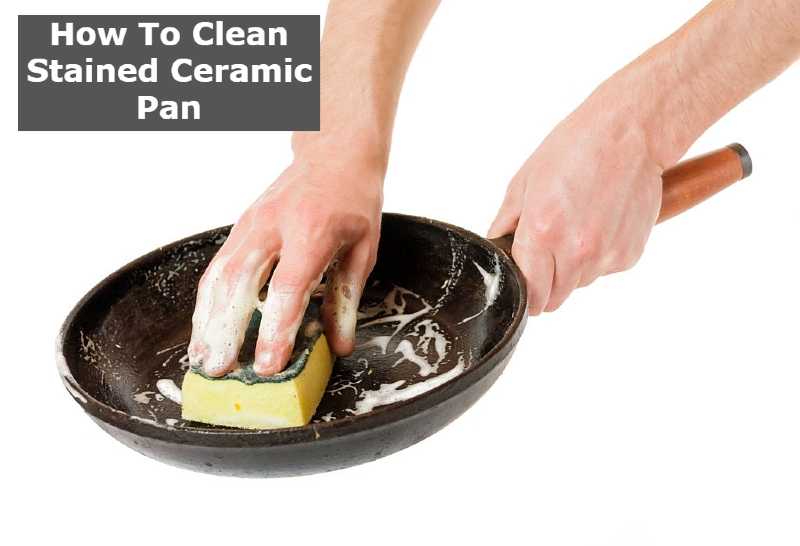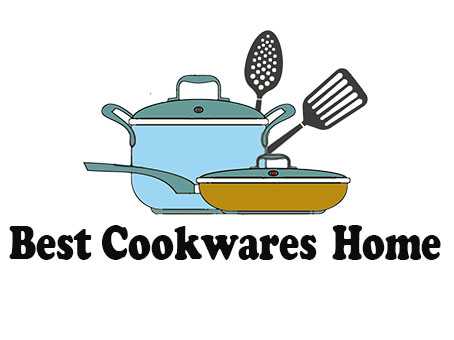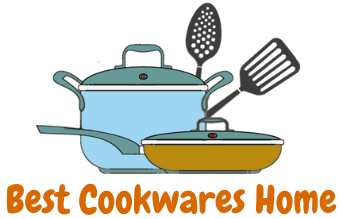
If you’ve ever used a ceramic-coated cookware set, you know that food residue sticks to the surface no matter how much you scrape it off. Over time, ceramic cookware will become stained or discolored.
Ceramic-coated pots and pans are often used by families because the food doesn’t stick to the surface. These highly functional pieces of cookware help people save time, money, and hassle in the kitchen.
When you put a metal spatula or spoon into a heated ceramic pan, it can scrape off this surface and cause scratches on the ceramic. Scratches affect the non-stick feature of a ceramic pan, by lessening its ability to release food from its surface.
However, it is possible to clean them if you use the right methods. And even if ceramic pans are stained, they can still be used.
Cleaning a ceramic pan after the food has been cooked is fairly easy. But if food is burned on, or baked-on from high heat, it can be a challenge to remove the stains from the pan. Below are some tips for removing burnt food from a ceramic pan.
Summary
How to Clean and Remove Stains From a Ceramic Pan
Preparation
Before you begin cleaning, prepare the pan with some warm water, which will help open up the pores of the ceramic. This makes it easier for food particles to come off of the surface.
Method 1
Rinse your pan under running cold tap water. Fill the sink with cold water and add a drop or two of dishwashing liquid. Use a plastic scouring pad to gently rub the surface of the pan.
If you have a ceramic skillet that is discolored, use a mixture of baking soda and water instead. Pour enough baking soda so that there is approximately one tablespoon for each cup of water used. Mix it well then, add a little bit of water to the mixture and mix it again until it is frothy.
Apply this mixture onto the surface of your ceramic pan with a sponge. Scrub thoroughly and then rinse off under cold running water or wipe clean with a cloth or paper towel. If necessary, re-apply some more mixture and scrub again lightly with a sponge.
Method 2
Boil some water in your pan over the stove. Once it reaches boiling point, turn the heat down to allow it to simmer for about 5 minutes. Add enough baking soda (about 2 tablespoons) and stir it into the water until you see bubbles forming. Wash the pan with cold water when done.
Method 3: (For badly stained pans)
Makeshift Oven Cleaner: Mix baking soda and enough water to form a paste. Apply the paste onto the surface then cover it with aluminum foil or clingfilm. You can use another bowl filled with baking soda to keep the top of the foil in place. Bake the paste-covered pan in a preheated 200C oven or until it dries out.
Let the pan cool down, then remove the foil and use a scouring pad to scrub any surface dirt off. Rinse with cold water and dry with a cloth or paper towel.
Method 4
Combine equal parts of hydrogen peroxide and baking soda to form a paste. Spread this mixture onto the surface of your ceramic pan in an even layer, then let it sit for 10 minutes. Rinse with cold water and dry with a cloth or paper towel.
In this way, you can clean a ceramic pan and remove stains from it. For extra protection, you can season your cookware by applying a light coat of vegetable oil after each wash.
How to Clean Ceramic Pans With Baking Soda and Vinegar
Here are the important steps you need to follow when cleaning stained ceramic pans:
- Cleaning a stained ceramic pan with baking soda and vinegar is one of the easiest ways to remove stains from ceramic cookware. It’s also effective for removing melted plastic that has been burnt onto your frying pans.
- Mix 1 tablespoon of baking soda with 2 tablespoons of water and place this mixture in the ceramic pan. Pour 2 tablespoons of white vinegar over the baking soda mixture.
- Cover the pan with a dish towel and let it soak for several hours or overnight before you wash it off with warm water.
- Wash the stained or discolored ceramic cookware with lukewarm soapy water to remove any remaining food or baking soda residue from the ceramic pan.
- If this method still didn’t remove all the food stains, you can try using a paste made from baking soda and water applied with a clean cloth or sponge. Let it sit for 30 minutes before rinsing it off thoroughly with warm water.
How to Clean a Stained Ceramic Pan That Has Burnt on Food
For tough stains that don’t come out with baking soda and water, try using a paste made from coarse salt and vinegar. Mix 2 tablespoons of kosher salt with 1 tablespoon of white vinegar and enough water to form a thick paste. Apply the salt and vinegar paste to the stained ceramic pan with a damp sponge or cloth, and let it sit for 30 minutes. Rinse the ceramic cookware with warm water to remove any salt or vinegar residue.
You can also use lemon juice, scrubbing it into the surface with a cloth or sponge. Let it soak for 10 minutes before rinsing with warm water. This process should help lift any burnt-on food residue from the ceramic cookware.
You can also use a non-abrasive powder cleanser and a damp sponge to clean stained ceramic pans. Apply the cleanser with gentle circular motions, then rinse it away with warm water. You may need to follow this process more than once before food residue is completely removed from your ceramic pan.
How to remove hard water stains from ceramic cookware
Many people find that their ceramic pans get stained or discolored with use. If you have a stubborn stain on your pan, try cleaning it with cream of tartar and lemon juice, which is also effective in removing burned food residue from the surface.
Mix 1 teaspoon of cream of tartar with 1 tablespoon of lemon juice. Add a little bit of water to form a thin paste, then apply it to the stained or discolored area on the ceramic cookware with a damp cloth or sponge. Let this solution sit for 10 minutes before rinsing it off completely with warm water.
Another method is to use baking soda and cream of tartar. Mix 2 teaspoons of cream of tartar with a few drops of lemon juice and enough baking soda to form a thick paste. Apply the mixture on the stained areas on the ceramic cookware, using a damp sponge or cloth. Cover it with plastic wrap and let it sit for 10 minutes before rinsing the pan under warm water.
Tips to Keep Your Ceramic Pans and Cookware Last Longer
Here are the things you can do to make your ceramic pans last longer:
Clean the pan right after use
When you are done cooking, clean the pan as soon as possible. This is because if you let food or liquid sit on the surface of a ceramic pan, it will harden and become difficult to remove.
Use nonabrasive cleaners
Don’t use metal utensils or abrasive cleaners when removing food residue from the surface of the cookware. If there are stubborn food stains on your pan, add a little water and leave it on for 20-30 minutes before washing it off with warm soapy water.
Don’t soak the ceramic cookware in water
Never soak a ceramic pan for too long with water. This may cause the saucepan to crack and affect its ability to retain heat.
Avoid placing it on high temperature
Don’t put your pot or pan over direct flame, as this may cause damage to the surface of the cookware. Ceramic pans can be used on induction stoves, gas, and electric cooktops.
Store it properly
When not using a ceramic pan or pot, always store it in a sealed container or plastic bag to prevent dust from settling on the surface of the cookware. If there is a thin film of oil rendering on your pan, it’s okay to leave it overnight. But if you don’t plan on using the cookware for a while, wash the surface of the pan until it is completely dry. Dehydrated pans can cause food to stick to the surface more easily, shortening the lifespan of your ceramic cookware.
Avoid putting them in dishwasher
Ceramic cookware should only be hand-washed with a soft sponge and warm soapy water. Dishwashers can cause the surface of ceramic pans to lose their nonstick properties, distort the shape, and chip off into your food.
Use them regularly
To ensure that your ceramic cookware lasts longer, use it regularly. If you don’t plan on using your ceramic cookware for some time, store it properly to prevent dust from settling on the surface.
Stay away from harsh chemicals
If you clean or store your pan with chemical products that contain bleach or chlorine, this may cause damage to the surface. For older pans that cannot be restored to their original state, it’s okay to use these chemicals. But if you have a new pan, try to avoid them as much as possible.
Use wooden spoons
If you plan on cooking acidic foods, like tomato sauce or lemon juice, it’s best to use wooden spoons and plastic utensils when stirring the food during cooking. Metal utensils may discolor the surface of ceramic cookware.
Inspect regularly
If you are using a nonstick pan, inspect the surface regularly to check for damage or tiny scratches. These can cause your dish to stick onto the surface, so it’s best to have them repaired before they get worse. If there are already visible signs of damage on the surface, it’s best to replace your pan.
Avoid using oven cleaner
Do not use an oven cleaner when cleaning ceramic pans. This is because the high temperature of the oven will damage the cookware and release fumes that can be dangerous to inhale. If you have no choice but to use an oven cleaner, make sure that you don’t inhale the fumes, especially if you have respiratory problems.
How to make my ceramic cookware like new again
- Ceramic cookware is known for its beauty and durability, but after using it for a long time, it can lose its luster. If you want to restore your old pots and pans or if you just bought your first ceramic cookware, here are some tips on how you can do that
- For older pans that have lost their shine, clean the surface with a damp kitchen sponge and dishwashing liquid to remove any greasy dirt.
- Rinse using warm water and dry immediately. This will remove residues that may affect the nonstick coating of your cookware when you use them next time.
- To get rid of stains, try scrubbing the discolored area with a soft sponge and dishwashing liquid.
- If the stains are difficult to remove, you can make a paste by mixing baking soda with a few drops of water and apply the resulting mixture to the stain. Then let it sit for 20 minutes before rinsing and scrubbing.
- You can also use a paste made of baking powder or cream of tartar and hydrogen peroxide for stubborn stains
- To clean burnt marks, you can use a damp kitchen sponge, dishwashing liquid, and baking soda. After applying the mixture to the affected area, let it sit for about 40 minutes before washing with water.
- Periodic use of a stainless steel cleaner will help restore your cookware’s original shine and luster. Simply apply it to the affected area using a soft sponge or cotton cloth.
- To remove rust spots, you can scrub them with steel wool dipped in vinegar or lemon juice.
Related Post: How to Clean Pots and Pans to Look like New
Frequently Asked Questions
Q How to clean outside of ceramic pan?
According to the ceramic cookware manufacturer, you should only use a soft sponge and warm soapy water to clean your pot or pan. If there is food residue on the surface of your pot or pan, add some water and let it sit for 20-30 minutes before scrubbing the pan with a soft sponge. Do not soak ceramic cookware for a long time as it can cause the saucepan to crack and affect its ability to retain heat.
Q What kind of pan is good for a small family?
If you are looking for a nonstick pan that will allow you to cook your meals quickly, then it would be best to look into buying a ceramic cookware set. Ceramic cookware sets come in different sizes and styles so you can pick and choose how many saucepans, frying pans, and pots you want in your collection. Most ceramics manufacturers offer their own unique models with features that will help speed up your cooking time, such as technology that allows the food to be cooked faster or even made healthier by trapping less fat and oil in the meal. You can find a lot of ceramic cookware sets online or at retail stores.
Q How to clean ceramic pan burnt?
If there is burnt food residue stuck in your pan, you should boil some water and let it sit for around 30 minutes before cleaning the pan. You can use a soft sponge to remove the burnt particles or if they are difficult to remove, let the pan soak overnight in warm water.
Q What is the ceramic coating?
A Ceramic coating is a non-stick coating that can be applied to the inner surface of pots and pans. There are three types of ceramic coatings: zirconium oxide, titanium dioxide, and silicon carbide. The most common type in use today is titanium dioxide.
Q How to clean burnt oil from ceramic pan?
If there is burnt oil on the surface of your ceramic cookware, you can use a bar of dishwashing soap to scrub away the particles. You should also try boiling water in the pan and let it sit for a few minutes before cleaning with a soft sponge or rag.
Q What cooking utensils are suitable for ceramic pans?
Avoid using metal utensils on ceramic cookware as they may cause the surface to scratch, causing your pan to lose its nonstick properties and discolor over time. Hard plastic utensils may also damage the surface of your cookware, so it’s better to use wooden spoons and rubber spatulas when cooking in your ceramic pans.
Final Thoughts
When cooking, use the proper amount of oil needed to prevent foods from sticking onto your pan. Keep in mind that ceramic pans should only be used on low to medium heat. Higher temperatures can cause damage to the nonstick surface and shorten its lifespan. The above-mentioned tips can help you in cleaning the stained ceramic pans and pots.
If you take care of your pan properly, it will last for a long time before needing to be replaced. By following the above-mentioned tips, you can ensure that your pan will last for many years of cooking delicious meals.
Always make sure to inspect and clean the cookware properly before cooking with them. If you’re planning on purchasing ceramic pans, remember to buy the ones that are manufactured by trusted brands.
Related Post
How Long Does Ceramic Cookware Last
Is Ceramic Coated Aluminum Cookware Safe
How Long Do Ceramic Pans Last? Tips And Guide

Hi, Welcome to our Blog. We are a team of Professional Blogger and expert in Cookware, Kitchen Appliances. We Work for the latest Reviews for Cookware, Kitchen Appliances. You can give us your kind Suggestions for improvements of Blogs, Thank You
